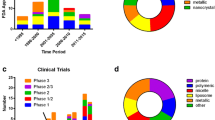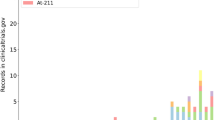Abstract
Background and Objective
HY-088 injection is an ultrasmall superparamagnetic iron oxide nanoparticle (USPIOs) composed of iron oxide crystals coated with polyacrylic acid (PAA) on the surface. The purpose of this study was to investigate the pharmacokinetics, tissue distribution, and mass balance of HY-088 injection.
Methods
The pharmacokinetics of [55Fe]-HY-088 and [14C]-HY-088 were investigated in 48 SD rats by intravenous injection of 8.5 (low-dose group), 25.5 (medium-dose group), and 85 (high-dose group) mg/100 μCi/kg. Tissue distribution was studied by intravenous injection of 35 mg/100 μCi/kg in 48 SD rats, and its tissue distribution in vivo was obtained by ex vivo tissue assay. At the same time, [14C]-HY-088 was injected intravenously at a dose of 25.5 mg/100 μCi/kg into 16 SD rats, and its tissue distribution in vivo was studied by quantitative whole-body autoradiography. [14C]-HY-088 and [55Fe]-HY-088 were injected intravenously into 24 SD rats at a dose of 35 mg/100 μCi/kg, and their metabolism was observed.
Results
In the pharmacokinetic study, [55Fe]-HY-088 reached the maximum observed concentration (Cmax) at 0.08 h in the low- and medium-dose groups of SD rats. [14C]-HY-088 reached Cmax at 0.08 h in the three groups of SD rats. The area under the concentration–time curve (AUC) of [55Fe]-HY-088 and [14C]-HY-088 increased with increasing dose. In the tissue distribution study, [55Fe]-HY-088 and [14C]-HY-088 were primarily distributed in the liver, spleen, and lymph nodes of both female and male rats. In the mass balance study conducted over 57 days, the radioactive content of 55Fe from [55Fe]-HY-088 was primarily found in the carcass, accounting for 86.42 ± 4.18% in females and 95.46 ± 6.42% in males. The radioactive recovery rates of [14C]-HY-088 in the urine of female and male rats were 52.99 ± 5.48% and 60.66 ± 2.23%, respectively.
Conclusions
Following single intravenous administration of [55Fe]-HY-088 and [14C]-HY-088 in SD rats, rapid absorption was observed. Both [55Fe]-HY-088 and [14C]-HY-088 were primarily distributed in the liver, spleen, and lymph nodes. During metabolism, the radioactivity of [55Fe]-HY-088 is mainly present in the carcass, whereas the 14C-labeled [14C]-HY-088 shell PAA is eliminated from the body mainly through the urine.

Similar content being viewed by others
References
Leong SP, Pissas A, Scarato M, Gallon F, Pissas MH, Amore M, et al. The lymphatic system and sentinel lymph nodes: conduit for cancer metastasis. Clin Exp Metastasis. 2022;39(1):139–57. https://doi.org/10.1007/s10585-021-10123-w.
Marino MA, Avendano D, Zapata P, Riedl CC, Pinker K. Lymph node imaging in patients with primary breast cancer: concurrent diagnostic tools. Oncologist. 2020;25(2):e231–42. https://doi.org/10.1634/theoncologist.2019-0427.
Datta K, Muders M, Zhang H, Tindall DJ. Mechanism of lymph node metastasis in prostate cancer. Future Oncol. 2010;6(5):823–36. https://doi.org/10.2217/fon.10.33.
Wang W, Qiu P, Li J. Internal mammary lymph node metastasis in breast cancer patients based on anatomical imaging and functional imaging. Breast Cancer. 2022;29(6):933–44. https://doi.org/10.1007/s12282-022-01377-7.
Ma D, Zhang Y, Shao X, Wu C, Wu J. PET/CT for predicting occult lymph nodemetastasis in gastric cancer. Curr Oncol. 2022;29(9):6523–39. https://doi.org/10.3390/curroncol29090513.
Bilchik AJ, Hoon DS, Saha S, Turner RR, Wiese D, DiNome M, et al. Prognostic impact of micrometastases in colon cancer: interim results of a prospective multicenter trial. Ann Surg. 2007;246(4):568–75. https://doi.org/10.1097/SLA.0b013e318155a9c7. (discussion 75-7).
Rosen JE, Chan L, Shieh DB, Gu FX. Iron oxide nanoparticles for targeted cancer imaging and diagnostics. Nanomed-Nanotechnol. 2012;8(3):275–90. https://doi.org/10.1016/j.nano.2011.08.017.
Di Marco M, Sadun C, Port M, Guilbert I, Couvreur P, Dubernet C. Physicochemical characterization of ultrasmall superparamagnetic iron oxide particles (USPIO) for biomedical application as MRI contrast agents. Int J Nanomed. 2007;2(4):609–22.
Lu Y, Huang J, Neverova NV, Nguyen KL. USPIOs as targeted contrast agents in cardiovascular magnetic resonance imaging. Curr Cardiovasc Imaging Rep. 2021. https://doi.org/10.1007/s12410-021-09552-8.
Huang Y, Hsu JC, Koo H, Cormode DP. Repurposing ferumoxytol: diagnostic and therapeutic applications of an FDA-approved nanoparticle. Theranostics. 2022;12(2):796–816. https://doi.org/10.7150/thno.67375.
Bourrinet P, Bengele HH, Bonnemain B, Dencausse A, Idee JM, Jacobs PM, et al. Preclinical safety and pharmacokinetic profile of ferumoxtran-10, an ultrasmall superparamagnetic iron oxide magnetic resonance contrast agent. Invest Radiol. 2006;41(3):313–24. https://doi.org/10.1097/01.rli.0000197669.80475.dd.
Daldrup-Link HE. Ten things you might not know about iron oxide nanoparticles. Radiology. 2017;284(3):616–29. https://doi.org/10.1148/radiol.2017162759.
Vasanawala SS, Nguyen KL, Hope MD, Bridges MD, Hope TA, Reeder SB, et al. Safety and technique of ferumoxytol administration for MRI. Magn Reson Med. 2016;75(5):2107–11. https://doi.org/10.1002/mrm.26151.
Islam T, Wolf G. The pharmacokinetics of the lymphotropic nanoparticle MRI contrast agent ferumoxtran-10. Cancer Biomark. 2009;5(2):69–73. https://doi.org/10.3233/cbm-2009-0579.
Zamecnik P, Israel B, Feuerstein J, Nagarajah J, Gotthardt M, Barentsz JO, et al. Ferumoxtran-10-enhanced 3-T magnetic resonance angiography of pelvic arteries: initial experience. Eur Urol Focus. 2022;8(6):1802–8. https://doi.org/10.1016/j.euf.2022.03.001.
Booth A, Størseth T, Altin D, Fornara A, Ahniyaz A, Jungnickel H, et al. Freshwater dispersion stability of PAA-stabilised cerium oxide nanoparticles and toxicity towards pseudokirchneriella subcapitata. Sci Total Environ. 2015;505:596–605. https://doi.org/10.1016/j.scitotenv.2014.10.010.
Zhang S, Ma X, Sha D, Qian J, Yuan Y, Liu C. A novel strategy for tumor therapy: targeted, PAA-functionalized nano-hydroxyapatite nanomedicine. J Mater Chem B. 2020;8(41):9589–600. https://doi.org/10.1039/d0tb01603a.
Arami H, Khandhar A, Liggitt D, Krishnan KM. In vivo delivery, pharmacokinetics, biodistribution and toxicity of iron oxide nanoparticles. Chem Soc Rev. 2015;44(23):8576–607. https://doi.org/10.1039/c5cs00541h.
Cho M, Villanova J, Ines DM, Chen J, Lee SS, Xiao Z, et al. Sensitive T2 MRI contrast agents from the rational design of iron oxide nanoparticle surface coatings. J Phys Chem C. 2023;127(2):1057–70. https://doi.org/10.1021/acs.jpcc.2c05390.
Dadfar SM, Roemhild K, Drude NI, von Stillfried S, Knüchel R, Kiessling F, et al. Iron oxide nanoparticles: diagnostic, therapeutic and theranostic applications. Adv Drug Deliver Rev. 2019;138:302–25. https://doi.org/10.1016/j.addr.2019.01.005.
Kim SG, Harel N, Jin T, Kim T, Lee P, Zhao F. Cerebral blood volume MRI with intravascular superparamagnetic iron oxide nanoparticles. NMR Biomed. 2013;26(8):949–62. https://doi.org/10.1002/nbm.2885.
Murray PJ, Wynn TA. Protective and pathogenic functions of macrophage subsets. Nat Rev Immunol. 2011;11(11):723–37. https://doi.org/10.1038/nri3073.
Chen K, Xie J, Xu H, Behera D, Michalski MH, Biswal S, et al. Triblock copolymer coated iron oxide nanoparticle conjugate for tumor integrin targeting. Biomaterials. 2009;30(36):6912–9. https://doi.org/10.1016/j.biomaterials.2009.08.045.
Levy M, Luciani N, Alloyeau D, Elgrabli D, Deveaux V, Pechoux C, et al. Long term in vivo biotransformation of iron oxide nanoparticles. Biomaterials. 2011;32(16):3988–99. https://doi.org/10.1016/j.biomaterials.2011.02.031.
Wolf GL. Macrophages hold the key to cancer’s inner sanctum. Med Hypotheses. 2019;122:111–4. https://doi.org/10.1016/j.mehy.2018.10.028.
Pesapane F, Czarniecki M, Suter MB, Turkbey B, Villeirs G. Imaging of distant metastases of prostate cancer. Med Oncol. 2018;35(11):148. https://doi.org/10.1007/s12032-018-1208-2.
Choi SH, Moon WK. Contrast-enhanced MR imaging of lymph nodes in cancer patients. Korean J Radiol. 2010;11(4):383–94. https://doi.org/10.3348/kjr.2010.11.4.383.
Kimura K, Tanigawa N, Matsuki M, Nohara T, Iwamoto M, Sumiyoshi K, et al. High-resolution MR lymphography using ultrasmall superparamagnetic iron oxide (USPIO) in the evaluation of axillary lymph nodes in patients with early stage breast cancer: preliminary results. Breast Cancer. 2010;17(4):241–6. https://doi.org/10.1007/s12282-009-0143-7.
Birkhäuser FD, Studer UE, Froehlich JM, Triantafyllou M, Bains LJ, Petralia G, et al. Combined ultrasmall superparamagnetic particles of iron oxide-enhanced and diffusion-weighted magnetic resonance imaging facilitates detection of metastases in normal-sized pelvic lymph nodes of patients with bladder and prostate cancer. Eur Urol. 2013;64(6):953–60. https://doi.org/10.1016/j.eururo.2013.07.032.
Hauger O, Grenier N, Deminère C, Lasseur C, Delmas Y, Merville P, et al. USPIO-enhanced MR imaging of macrophage infiltration in native and transplanted kidneys: initial results in humans. Eur Radiol. 2007;17(11):2898–907. https://doi.org/10.1007/s00330-007-0660-8.
Scally C, Abbas H, Ahearn T, Srinivasan J, Mezincescu A, Rudd A, et al. Myocardial and systemic inflammation in acute stress-induced (takotsubo) cardiomyopathy. Circulation. 2019;139(13):1581–92. https://doi.org/10.1161/circulationaha.118.037975.
Acknowledgements
The authors sincerely thank all members of QWBA and the tissue distribution studies team at InnoStar Bio-tech Nantong Co., Ltd. We also thank Sichuan Huiyu Seacross Pharmaceutical Co., Ltd. for providing the nano-innovative drugs for this experiment.
Author information
Authors and Affiliations
Corresponding authors
Ethics declarations
Funding
This study was funded by Jiangsu Province New Drug One-Stop Efficient Non-clinical Evaluation Public Service Platform Construction BM2021002.
Conflicts of Interest
Minglan Zheng is an employee of Yangtze River Delta Center for Drug Evaluation and Inspection of NMPA. Heping Hu, Zhao Ding, and Guangyu Fu are employees of Sichuan Huiyu Seacross Pharmaceutical Co., Ltd. Lei Chen, Shuzhe Wang, Ling Zhang, and Bohua Xu are employees of InnoStar Bio-tech Nantong Co., Ltd. Yunliang Qiu is an employee of Shanghai InnorStar Biotech Co., Ltd. The other authors declare no competing interests.
Author Contributions
Xin Song: substantial contributions to the machine learning and interpretation of data for the work; drafting the work manuscript. Minglan Zheng: interpretation of data for the work; reviewing the manuscript. Heping Hu: interpretation of data for the work; reagent HY-088 injection was provided; reviewing the manuscript. Lei Chen: substantial contributions to conduct the machine learning and interpretation of data for the work. Shuzhe Wang: substantial contributions to conduct the machine learning and interpretation of data for the work; participated in research design. Zhao Ding: reviewing the manuscript; reagent HY-088 injection was provided; Guangyi Fu: reviewing the manuscript; reagent HY-088 injection was provided. Luyao Sun: interpretation of data for the work. Liyuan Zhao: interpretation of data for the work. Ling Zhang: substantial contributions to conduct the machine learning and interpretation of data for the work. Bohua Xu: substantial contributions to conduct the machine learning and interpretation of data for the work; interpretation of data for the work; reviewing the manuscript; final approval of the version to be published. Yunliang Qiu: reviewing the manuscript; final approval of the version to be published.
Availability of Data and Material
The data that support the findings of this study are available from the corresponding author upon reasonable request.
Ethics Approval
All animal experiments in this study were approved by the Institutional Animal Care and Use Committee of InnoStar Bio-tech Nantong Co., Ltd. Approval numbers: 2021-583 (2021.09.07), IACUC-2022-r-005a (2022.01.06), IACUC-2022-r-104 (2022.02.18), IACUC-2022-r-446 (2022.08.01), and IACUC-2022-r-626 (2022.10.17).
Consent to Participate
Not applicable.
Consent for Publication
Not applicable.
Supplementary Information
Below is the link to the electronic supplementary material.
Rights and permissions
Springer Nature or its licensor (e.g. a society or other partner) holds exclusive rights to this article under a publishing agreement with the author(s) or other rightsholder(s); author self-archiving of the accepted manuscript version of this article is solely governed by the terms of such publishing agreement and applicable law.
About this article
Cite this article
Song, X., Zheng, M., Hu, H. et al. Pharmacokinetic Study of Ultrasmall Superparamagnetic Iron Oxide Nanoparticles HY-088 in Rats. Eur J Drug Metab Pharmacokinet 49, 317–330 (2024). https://doi.org/10.1007/s13318-024-00884-6
Accepted:
Published:
Issue Date:
DOI: https://doi.org/10.1007/s13318-024-00884-6




